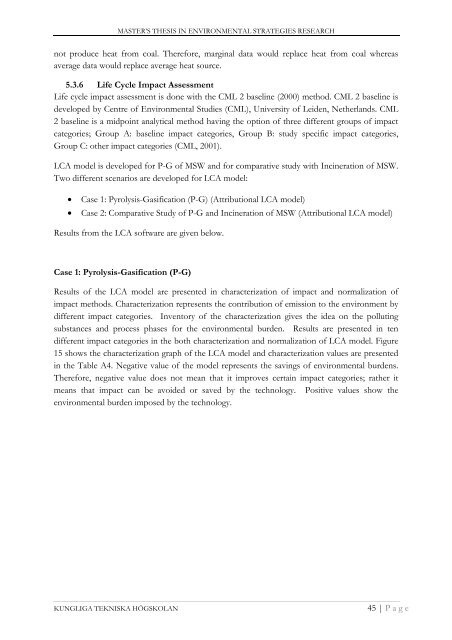Technical Development of Waste Sector in Sweden: Survey
Technical Development of Waste Sector in Sweden: Survey
Technical Development of Waste Sector in Sweden: Survey
You also want an ePaper? Increase the reach of your titles
YUMPU automatically turns print PDFs into web optimized ePapers that Google loves.
MASTER’S THESIS IN ENVIRONMENTAL STRATEGIES RESEARCH<br />
not produce heat from coal. Therefore, marg<strong>in</strong>al data would replace heat from coal whereas<br />
average data would replace average heat source.<br />
5.3.6 Life Cycle Impact Assessment<br />
Life cycle impact assessment is done with the CML 2 basel<strong>in</strong>e (2000) method. CML 2 basel<strong>in</strong>e is<br />
developed by Centre <strong>of</strong> Environmental Studies (CML), University <strong>of</strong> Leiden, Netherlands. CML<br />
2 basel<strong>in</strong>e is a midpo<strong>in</strong>t analytical method hav<strong>in</strong>g the option <strong>of</strong> three different groups <strong>of</strong> impact<br />
categories; Group A: basel<strong>in</strong>e impact categories, Group B: study specific impact categories,<br />
Group C: other impact categories (CML, 2001).<br />
LCA model is developed for P-G <strong>of</strong> MSW and for comparative study with Inc<strong>in</strong>eration <strong>of</strong> MSW.<br />
Two different scenarios are developed for LCA model:<br />
• Case 1: Pyrolysis-Gasification (P-G) (Attributional LCA model)<br />
• Case 2: Comparative Study <strong>of</strong> P-G and Inc<strong>in</strong>eration <strong>of</strong> MSW (Attributional LCA model)<br />
Results from the LCA s<strong>of</strong>tware are given below.<br />
Case 1: Pyrolysis-Gasification (P-G)<br />
Results <strong>of</strong> the LCA model are presented <strong>in</strong> characterization <strong>of</strong> impact and normalization <strong>of</strong><br />
impact methods. Characterization represents the contribution <strong>of</strong> emission to the environment by<br />
different impact categories. Inventory <strong>of</strong> the characterization gives the idea on the pollut<strong>in</strong>g<br />
substances and process phases for the environmental burden. Results are presented <strong>in</strong> ten<br />
different impact categories <strong>in</strong> the both characterization and normalization <strong>of</strong> LCA model. Figure<br />
15 shows the characterization graph <strong>of</strong> the LCA model and characterization values are presented<br />
<strong>in</strong> the Table A4. Negative value <strong>of</strong> the model represents the sav<strong>in</strong>gs <strong>of</strong> environmental burdens.<br />
Therefore, negative value does not mean that it improves certa<strong>in</strong> impact categories; rather it<br />
means that impact can be avoided or saved by the technology. Positive values show the<br />
environmental burden imposed by the technology.<br />
KUNGLIGA TEKNISKA HÖGSKOLAN<br />
45 | Page
















